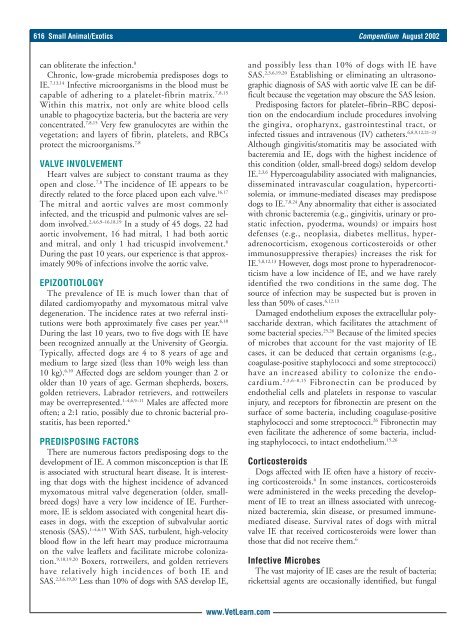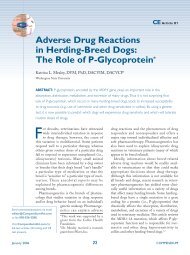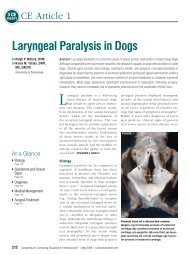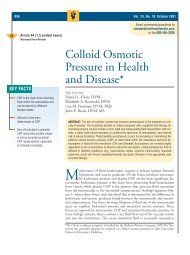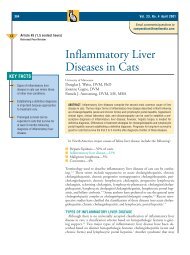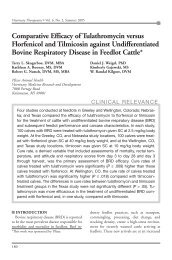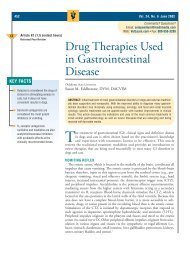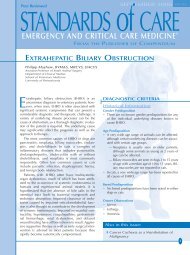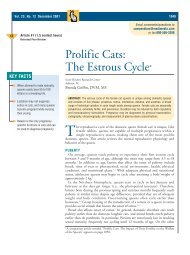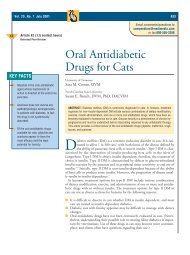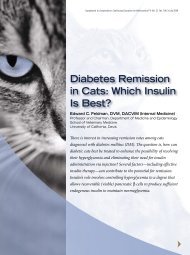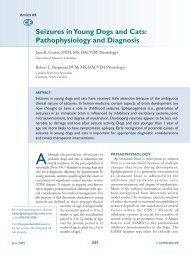Wall-July PV-Review - VetLearn.com
Wall-July PV-Review - VetLearn.com
Wall-July PV-Review - VetLearn.com
- TAGS
- cp.vetlearn.com
Create successful ePaper yourself
Turn your PDF publications into a flip-book with our unique Google optimized e-Paper software.
616 Small Animal/Exotics Compendium August 2002<br />
can obliterate the infection. 8<br />
Chronic, low-grade microbemia predisposes dogs to<br />
IE. 7,13,14 Infective microorganisms in the blood must be<br />
capable of adhering to a platelet-fibrin matrix. 7,8,15<br />
Within this matrix, not only are white blood cells<br />
unable to phagocytize bacteria, but the bacteria are very<br />
concentrated. 7,8,15 Very few granulocytes are within the<br />
vegetation; and layers of fibrin, platelets, and RBCs<br />
protect the microorganisms. 7,8<br />
VALVE INVOLVEMENT<br />
Heart valves are subject to constant trauma as they<br />
open and close. 7,8 The incidence of IE appears to be<br />
directly related to the force placed upon each valve. 16,17<br />
The mitral and aortic valves are most <strong>com</strong>monly<br />
infected, and the tricuspid and pulmonic valves are seldom<br />
involved. 2,4,6,9–16,18,19 In a study of 45 dogs, 22 had<br />
aortic involvement, 16 had mitral, 1 had both aortic<br />
and mitral, and only 1 had tricuspid involvement. 6<br />
During the past 10 years, our experience is that approximately<br />
90% of infections involve the aortic valve.<br />
EPIZOOTIOLOGY<br />
The prevalence of IE is much lower than that of<br />
dilated cardiomyopathy and myxomatous mitral valve<br />
degeneration. The incidence rates at two referral institutions<br />
were both approximately five cases per year. 6,10<br />
During the last 10 years, two to five dogs with IE have<br />
been recognized annually at the University of Georgia.<br />
Typically, affected dogs are 4 to 8 years of age and<br />
medium to large sized (less than 10% weigh less than<br />
10 kg). 6,10 Affected dogs are seldom younger than 2 or<br />
older than 10 years of age. German shepherds, boxers,<br />
golden retrievers, Labrador retrievers, and rottweilers<br />
may be overrepresented. 1–4,6,9–11 Males are affected more<br />
often; a 2:1 ratio, possibly due to chronic bacterial prostatitis,<br />
has been reported. 6<br />
PREDISPOSING FACTORS<br />
There are numerous factors predisposing dogs to the<br />
development of IE. A <strong>com</strong>mon misconception is that IE<br />
is associated with structural heart disease. It is interesting<br />
that dogs with the highest incidence of advanced<br />
myxomatous mitral valve degeneration (older, smallbreed<br />
dogs) have a very low incidence of IE. Furthermore,<br />
IE is seldom associated with congenital heart diseases<br />
in dogs, with the exception of subvalvular aortic<br />
stenosis (SAS). 1–4,6,19 With SAS, turbulent, high-velocity<br />
blood flow in the left heart may produce microtrauma<br />
on the valve leaflets and facilitate microbe colonization.<br />
9,10,19,20 Boxers, rottweilers, and golden retrievers<br />
have relatively high incidences of both IE and<br />
SAS. 2,3,6,19,20 Less than 10% of dogs with SAS develop IE,<br />
www.<strong>VetLearn</strong>.<strong>com</strong><br />
and possibly less than 10% of dogs with IE have<br />
SAS. 2,3,6,19,20 Establishing or eliminating an ultrasonographic<br />
diagnosis of SAS with aortic valve IE can be difficult<br />
because the vegetation may obscure the SAS lesion.<br />
Predisposing factors for platelet–fibrin–RBC deposition<br />
on the endocardium include procedures involving<br />
the gingiva, oropharynx, gastrointestinal tract, or<br />
infected tissues and intravenous (IV) catheters. 6,8,9,12,21–23<br />
Although gingivitis/stomatitis may be associated with<br />
bacteremia and IE, dogs with the highest incidence of<br />
this condition (older, small-breed dogs) seldom develop<br />
IE. 2,3,6 Hypercoagulability associated with malignancies,<br />
disseminated intravascular coagulation, hypercortisolemia,<br />
or immune-mediated diseases may predispose<br />
dogs to IE. 7,8,24 Any abnormality that either is associated<br />
with chronic bacteremia (e.g., gingivitis, urinary or prostatic<br />
infection, pyoderma, wounds) or impairs host<br />
defenses (e.g., neoplasia, diabetes mellitus, hyperadrenocorticism,<br />
exogenous corticosteroids or other<br />
immunosuppressive therapies) increases the risk for<br />
IE. 5,8,12,13 However, dogs most prone to hyperadrenocorticism<br />
have a low incidence of IE, and we have rarely<br />
identified the two conditions in the same dog. The<br />
source of infection may be suspected but is proven in<br />
less than 50% of cases. 6,12,13<br />
Damaged endothelium exposes the extracellular polysaccharide<br />
dextran, which facilitates the attachment of<br />
some bacterial species. 25,26 Because of the limited species<br />
of microbes that account for the vast majority of IE<br />
cases, it can be deduced that certain organisms (e.g.,<br />
coagulase-positive staphylococci and some streptococci)<br />
have an increased ability to colonize the endocardium.<br />
2,3,6–8,15 Fibronectin can be produced by<br />
endothelial cells and platelets in response to vascular<br />
injury, and receptors for fibronectin are present on the<br />
surface of some bacteria, including coagulase-positive<br />
staphylococci and some streptococci. 26 Fibronectin may<br />
even facilitate the adherence of some bacteria, including<br />
staphylococci, to intact endothelium. 15,26<br />
Corticosteroids<br />
Dogs affected with IE often have a history of receiving<br />
corticosteroids. 6 In some instances, corticosteroids<br />
were administered in the weeks preceding the development<br />
of IE to treat an illness associated with unrecognized<br />
bacteremia, skin disease, or presumed immunemediated<br />
disease. Survival rates of dogs with mitral<br />
valve IE that received corticosteroids were lower than<br />
those that did not receive them. 6<br />
Infective Microbes<br />
The vast majority of IE cases are the result of bacteria;<br />
rickettsial agents are occasionally identified, but fungal


